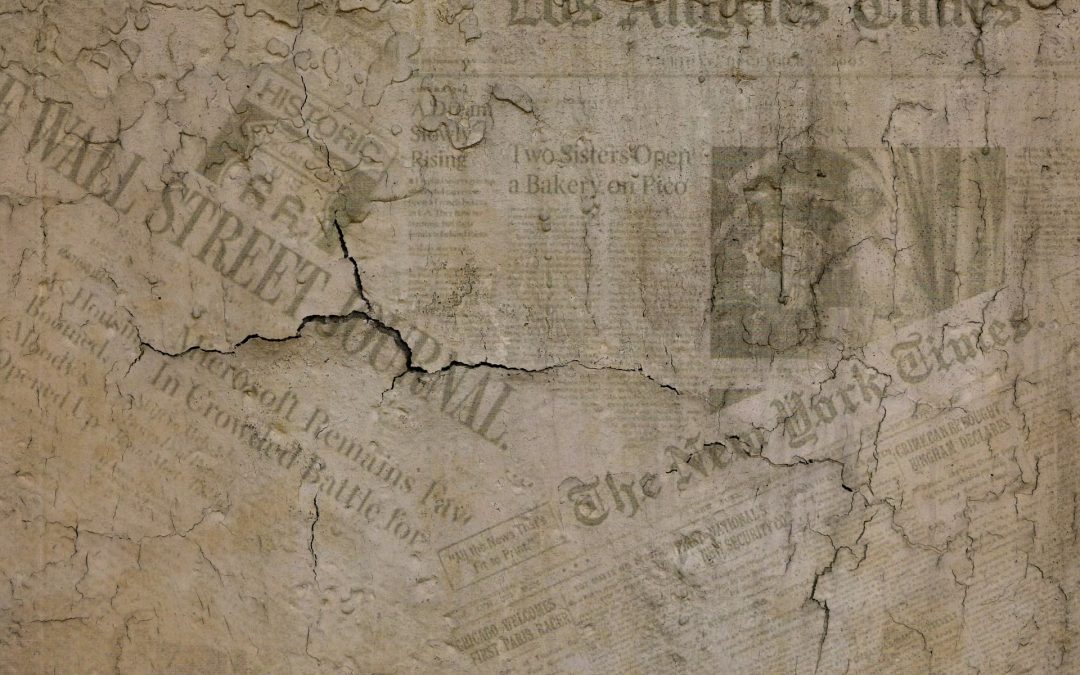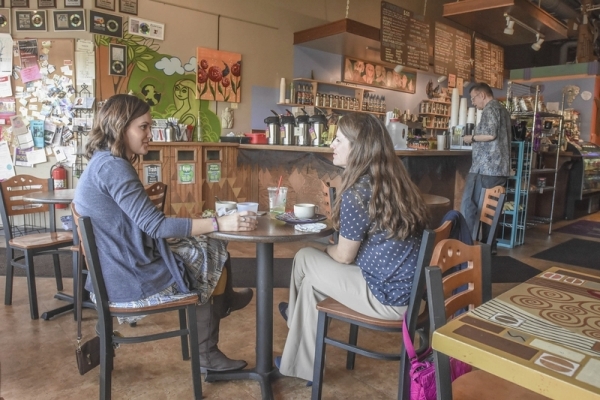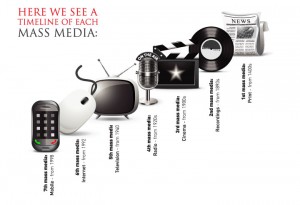
by Scott Howard | Jul 31, 2019 | Marketing and Advertising Insights, ScLoHo's Collective Wisdom, The Not-So-Secret Writings of ScLoHo, WOWO Fort Wayne Radio Advertising with Scott Howard
I could have titled this:
Dead Advertising Mediums.
Read this from Roy H. Williams:
Google is the new phone book. Like the Yellow Pages of yesterday, it is the principal resource for buyers who are currently, consciously in the market for a product or service and have no preferred provider. Like the White Pages of yesterday, Google delivers your telephone number, street address, (and business hours) to customers who have already chosen you as their preferred provider.
Customers who come to you through mass media will often be credited to your digital efforts due to the “White Pages” function of Google. They had already chosen you as their preferred provider, but were looking online for your street address, phone number, or business hours.
That is the 7th and 8th points from a newsletter that Roy H. Williams wrote earlier this year that I’m doing a series on right now as a ScLoHo extra. Go here to read all 20 points.
Advertising in the phone book is a complete waste of money in the United States of America.
I’ve been preaching this for years.
I have nothing against printed ads, it’s just, like Roy says, not needed at least in the phone book.
I have nothing to add to what Roy said, except an observation from earlier this month.
On Wednesday July 3rd, I was in the waiting room of a service department getting my car’s air conditioning back in shape for the 90+ degree temps and here’s what I observed.
About a dozen people ranging in age from about 8 to 80 were also in the waiting room. One was reading a book, everyone else had a mobile phone or tablet that they were using.
A TV was on, but was being ignored by most everyone.
There were also two newspapers that sat untouched on a table until I opened them up.
The Wall Street Journal and our local morning paper the Fort Wayne Journal Gazette.
The Wall Street Journal had 28 pages total and an appropriate number of ads, but they could have had a few more.
But 28 pages, that is pretty slim for a national newspaper. Kind of sad.
What was worse was the local paper.
24 total pages. Maybe 4 pages worth of ads plus the classifieds. They could not make money with this pitiful amount of paid ads. This was the day before the 4th of July and a few decades ago it would have been stuffed full of ads for holiday sales and now… nothing.
Sadly for the future of these papers, no one cared to even read the paper.
As a kid, I used to be a paperboy, delivering every afternoon when I got home from school.
These days, no one seems to read the daily newspapers and with a lack of readers the advertisers ads are not getting seen.
Everyone sitting in the waiting room was watching and reading their own personal screens.
Is it any wonder that there are so few ads and so few pages printed?
Mass media isn’t dead, but certain mediums are.
Contrast the phone book and newspapers with the data about the mass media I work in.
Radio. Surveys continue to show that over 90% of people in the United States of America listen every week.
We got the results for radio listening in Fort Wayne and my station, WOWO radio has the largest weekly audience with over 140,000 people choosing to listen to WOWO every week. Unlike the newspaper that just sits there untouched. Or the phone books that get tossed in the recycling bins the day they are delivered.
If you are paying to advertise in the phone book or a newspaper, let’s talk. Email me: Scott@WOWO.com
[wd_hustle id="sound-advice-sign-up" type="embedded"]

by Scott Howard | Sep 5, 2017 | Marketing and Advertising Insights, ScLoHo's Fort Wayne, ScLoHo's Media, The Not-So-Secret Writings of ScLoHo, WOWO Fort Wayne Radio Advertising with Scott Howard
Where do you get your local news? Is traditional media dead yet?
These two questions have been on my mind for quite awhile and then last month we learned that a Fort Wayne news institution was making a major change:
The News-Sentinel is ending distribution of its afternoon newspaper as it shifts to a digital platform, Fort Wayne Newspapers announced.
Subscribers will still be offered News-Sentinel content in the morning Journal Gazette, as part of a renewal of the two newspapers’ joint operating agreement.
I wasn’t surprised, but I was saddened. In my youth, I was a paperboy of the afternoon paper in Fort Wayne and had a fondness for the paper even though it has been years since I bought one.
The survival of two local daily newspapers in a city the size of Fort Wayne was only due to some planning decades ago that allowed the morning and afternoon newspapers that were independently owned to form a Joint Operating Agreement. This J.O.A. was limited to advertising revenue and kept the news and editorial staffs separate for each paper.
For the past dozen years, I have had access to publication numbers of the two newspapers because of my affiliation with the Radio Advertising Bureau and their access to the numbers reported to the Audit Bureau of Circulations that keeps track of this data.
In 1999, the afternoon paper had over 45,000 subscribers, and that number was in the 20 thousand range 10 years later. The last report I have access to listed a total of 12,000 weekly subscribers to the News-Sentinel back in 2014 and odds are they were less than 10 thousand last week.
This is not just a local phenomenon. The decline of printed daily newspaper circulation has been going on for decades with alternatives popping up online. Many papers moved their content online and used those numbers to boost their subscription numbers that they would report, but the revenue didn’t match up.
A few years ago, I had coffee with a young woman who was in charge of selling digital advertising for the Fort Wayne Newspapers and I remember my advice:
Your job is going to be to keep advertisers spending levels where they are today. The businesses are going to decrease their spending in the printed paper and you can help them stay by migrating those funds into digital products.
I laid out a 5 year plan and at the end of those 5 years, 90% of an advertisers budget was being spent in digital media with the remaining 10% on a souvenir collectors edition of the printed newspaper. She wasn’t allowed to follow my advice and now she works elsewhere.
A couple years later, after I was interviewed to become the Digital Advertising Sales Manager for the Fort Wayne Newspapers they decided to eliminate the position and combine the sales departments of both digital and print.
So where do we as consumers get our news? I still see people reading the morning paper in Fort Wayne on the days I visit a coffee shop. But those numbers have been declining too.
Fort Wayne has over 20 radio stations and a number of TV stations. The television stations that offer local news include a CBS, ABC, NBC and Fox affiliate. According to the ratings, the CBS station has double the audience for local news over the ABC station and the NBC stations audience didn’t hardly register in the latest survey. The Fox station has one newscast at a time that no one else does (10 pm).
On the radio side, WOWO Radio is the only station with a fully staffed full time news staff that does live local news every 30 minutes from 5am until 6pm weekdays, and more frequently between 5 and 9am. Yes, there are other stations that offer local news, but not all day and not to the degree that WOWO does. WOWO has additional news sources and providers in neighboring communities from our co-owned stations in Warsaw, Elkhart, South Bend and Goshen along with “news-partners” at local print and TV stations.
Long ago, WOWO’s news slogan was, “Where you go when you need to know”, and as a News Talk formatted radio station for over 20 years, the commitment remains. WOWO recognized that where we get out news continues to evolve. Nearly every local news story is found on WOWO.com.
News and Weather alerts are sent via text to subscribers. Updates on Facebook and Twitter are posted online too. WOWO is owned by Federated Media and WOWO supplies the news to our sister stations in Fort Wayne including WMEE, 98.9 The Bear & K-105.
Having worked for a couple of the other radio station groups, they simply don’t have a news department like WOWO & Federated Media. When I was there, it was more like grab the morning newspaper and pull a couple of headlines to rewrite and call it a newscast, style of news. And to be fair, there are two radio stations on the non-profit part of the FM dial that have news departments of varying degrees.
News is not the only reason we have traditional media. My original two questions when I started this were:
Where do you get your local news? Is traditional media dead yet?
Individual TV shows on the major broadcast networks can still find a healthy sized audience, but those networks are not filling all their prime time weekly slots with new shows. Lot’s of repeats will air on Friday and Saturday nights, I’ve observed. Broadcast TV is trying to adjust to the on-demand world of entertainment we have now.
Music radio stations have been battling alternatives for decades and usually are still winning if they are locally connected to their listeners and their community. The Radio Advertising Bureau still tells us that over 90% of folks age 13 and older listen to a radio station every week.
From a business standpoint, you as a business person need to understand that there are still some very valuable traditional media sources that you can use to advertise with. It’s just not the same as it was 30 years ago or even 10 years ago and it may require someone to help guide you to make smart decisions on where to advertise.
That’s where I can help. I make recommendations beyond what I can sell to you myself, when I see an opportunity that you should take advantage of. Want help? Let’s talk.

by Scott Howard | May 16, 2017 | Marketing and Advertising Insights, ScLoHo's Collective Wisdom, ScLoHo's Media, ScLoHo's Web World, The Not-So-Secret Writings of ScLoHo, WOWO Fort Wayne Radio Advertising with Scott Howard
Yesterday I was reading an article from MarketingCharts.com so you don’t have to, no, really I do enjoy looking at this kind of stuff and pulling out some of the highlights.
It relates to an upcoming podcast episode and article I wrote that will be debuting in a couple days, too.
Here’s the highlights:
- We are spending more time with “Media” than ever before. Over 12 hours a day. Technically this would have been impossible a few years ago, but not now. Which brings us to the second highlight:
- Multi-tasking is in full swing and for media that means watching more than one screen at the same time. Those smartphones are being used by more and more of us instead of staring at the TV screen like zombies when the commercials come on.
- Print Media is shrinking. Not just the number of pages or the number of readers, but the time spent reading newspapers and magazines by each person is dropping. Over the last 5 years, each of us who still read print spend 15 minutes less every day.
- Radio listening, according to the report is steady. More on this in a second.
- Time spent with Digital media continues to grow. No surprise to any of us right?
Those last two items, Radio and Digital are the two areas that I work in and can help you craft an effective plan to use radio and digital to grow your business. Want to know more? Ask me. Also check out this weeks Genuine ScLoHo Media & Marketing Podcast episode Thursday on this website. Here’s a link.
by Scott Howard | Dec 5, 2016 | Marketing and Advertising Insights, ScLoHo's Media, The Not-So-Secret Writings of ScLoHo
So really…Is Traditional Media Dead?
I’m going to look at this subject from a marketers perspective. And a consumers viewpoint. And focus on just one piece of the traditional media, daily newspapers.
Lots of businesses rely on traditional media and advertising options that have been the mainstay for decades. Radio, television, yellow pages, magazines and newspapers were the big ones.
Every one would get a phone book that included a yellow page section that businesses would pay for ad space so you and I as consumers could find a plumber or lawyer or whatever we needed that we didn’t already have.
The internet replaced the relevancy of the printed yellow pages as cellphones replaced land lines and printed phone books that were updated months in advance and published once a year became obsolete.
(I’m still listed in the printed phone book white pages with an address that I moved from 11 years ago and a phone number I disconnected 3 years ago.)
But let’s focus a second on the other printed form of advertising that is updated nearly every day.
Your local newspaper. A decade ago I predicted the death of their business model at the same time our local papers built a new multi-million dollar press and building. It was a stupid idea, but it didn’t kill the paper.
Last month a friend of mine who comes into the Firefly Coffee Shop everyday to do crosswords and drink a Venti cup of coffee told me he is in the Sunday newspaper. Jim is his name and Jim is in his 70’s. He told me that his picture was in the business section.
While Jim was looking around the coffee shop for a copy of the Journal-Gazette Business section to show me the picture of him, I sat at my laptop and found it and the story.

Jim was surprised that I could find nearly any story from the printed copy of the newspaper on their website. Here’s the irony:
Jim did not read the story in the newspaper and so he did not know the context of the picture except the picture was of two women and he was in the background. The headline read: Youth also flavor local java scene and it was about the increase of millennials visiting coffee shops.
As both technology changes and generations age, there is a shift in the way the public consumes media and gathers information. Many newspapers allow you to read a limited number of articles online free but the goal is to have you pay with an online subscription.
The newspaper business model is broken and attempts to fix it appear futile. The company I work for, Federated Media sold off the one newspaper they owned this year because it was not profitable. At least compared to the other media assets under the company umbrella. Without my personally speaking to the Dillie family that owns our company, I still know that the newspaper was a prized piece of the portfolio of media interests, and the sale of the paper was strictly a business move that they wished they didn’t have to do.
Mediapost shared some stats about newspaper revenues that include:
Gannett reported an 11.7% year-on-year drop in its third-quarter ad revenues and a 6.4% drop in its circulation revenues
Print advertising revenues for the three months that ended on September 25 fell 14.8%, led by a 35.1% reduction in national print advertising and a 19.1% reduction in preprints.
On the positive side, they shared this:
Digital advertising revenues were up 6.2%, compared to the quarter a year ago, Digital-only subscriptions grew 45%.
However:
Gannett plans to lay off roughly 350 employees, or around 2% of its total workforce of about 18,700.
Gannett, which is the nation’s largest newspaper publisher, with a portfolio that includes USA Today and more than 100 local publications
Layoff announcements like this are not new. They are continuous. These are not like the old layoff announcements companies used to make about temporary layoffs. These jobs are not coming back.
The online version of newspapers is not capable of supporting financially the printed version.
The short story on these and other numbers is that the newspaper business is still trying to stay alive but when they finally do find a formula that makes it possible to survive financially, it will be a tiny fragment of what we have now in 2016. And what we have now in 2016 is a fragment of what the newspaper industry was 20 years ago.
As a consumer, I don’t need the printed paper to stay informed. If the online version goes away, we’ll have other online news sources that don’t have the burden of overhead.
As an advertiser, the number of print readers I reach by ads in the newspaper will continue to grow old and die. I went to a funeral of a 95 year old this fall so we may be living longer, but like my friend Jim who is in his 70’s and his picture is in the paper, it doesn’t matter anymore.
Thoughts? Questions? Comments? Let’s talk.
by Scott Howard | Mar 21, 2016 | Marketing and Advertising Insights, ScLoHo's Media, ScLoHo's Web World, The Not-So-Secret Writings of ScLoHo, WOWO Fort Wayne Radio Advertising with Scott Howard
It’s a fascinating discussion when I ask people about their media habits in 2016. A lot has changed over the years with more options than ever and sometimes people ask me a variation of this question,
Is Mass Media Dead or Thriving?
It is actually thriving but in ways different than before.
Mass Media by definition is considered a form of media that is consumed by a large number of people. While that definition hasn’t changed in the past 100 years, the way that media is delivered and consumed has changed over the past 25 years.
For my purposes today, I’m going to address this from a marketing standpoint.
While we have seen the decline of newspapers and magazines, those that have survived have done so by reinventing themselves to appeal to a niche audience. It’s doubtful that we’ll ever have the dominance of a major print publication, even on the local level except where there are no other media options available. But then there’s the internet…
Television was dominated by ABC, CBS, NBC and then PBS and Fox came along to provide a few more viewing options. Unless you recorded a show on your own, you had to watch it live. This was an excellent way for advertisers to reach a bunch of people simultaneously with their commercials as we sat “glued to the tube”. Then with the expansion of networks and the ability to time shift and watch what ever we wanted, when ever we wanted, the simultaneous viewing of commercials began declining. But then there’s the internet…
Radio stations that play music have always had competition. As consumers we could buy the music and listen when ever we wanted to what ever we wanted. Music radio stations have always had competition for music listenership that went beyond other radio stations. Then with the expansion of choices including the internet…
Talk Radio stations have had a mix bag of competition. When I first started listening to WJR and WWJ in Detroit 30 years ago, I tuned it for information. Some talk stations don’t offer the information that listeners want and they have lost listeners because their are plenty of options including the internet…
As a side note, I looked at the listenership of the Fort Wayne radio stations and 4 of the top 5 stations have incredibly large audiences of over 100,000 weekly listeners. That’s 20% to 30% of the population, each of those stations reaches individually. WOWO, my station, and 3 of our sister stations that play music are in that top 5, out of over 25 stations in the Fort Wayne metro area.
The concept of Mass Media has changed. When there were fewer options, each option had more people reading/listening/viewing. Now we have the ability to personalize our media habits as consumers and as marketers.
I don’t need a newspaper subscription to read the local news. I can get the information online. I don’t need to watch CBS on Tuesday night at 8pm to see the latest episode of NCIS. I can watch it later On Demand with Comcast on my TV, laptop or smartphone. I don’t need many of the old medias on a daily basis the way my parents did.
Instead we get to choose. I can listen to the radio as I am driving to work to get the news, weather, sports and other information. A lot of people still do this. Even teens do this. Maybe not as many as their grandparents generation, but they still do.
For businesses that want to reach the masses, it’s do-able. We have plenty of options and we’ll look at those options next time.





